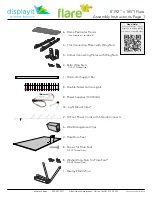
Note:
Exceptions to this may occur if there is a fault condition, the IntelliRupter fault
interrupter detects less than three-phase voltage present, or unequal phase-voltage
magnitudes are occurring.
• After phase rotation is measured, the measured-phase sequence is displayed on the
Metering
screen.
Note:
The measured System Phase Rotation displayed on the
Metering
screen
may be different than the
Phase Rotation
setpoint on the
Setup>General>Site-
Related>System>Phase Rotation
screen.
• After phase rotation is determined, it is not re-verified unless one of the following
events occur:
• Voltage is lost on both terminals.
• The 5-minute
Phase Rotation Reverification Timer
expires.
• Any new settings are applied.
For example, the
Metering
screen display of system-phase rotation may be delayed
five minutes if the terminal-phase associations have changed without a preceding
loss-of-voltage event on both terminals X & Y.
• At power up with all three poles open, and when terminals X & Y have unequal phase-
sequence voltages, the IntelliRupter fault interrupter presumes terminal-X voltage to
be positive sequence.
Phase Rotation
Phase rotation is automatically determined by the Protection and Control module.
Select the
123
,
132
, or
Undefined
option. The control will update this after making the
measurement.
Direction 1 / Direction 2
This setting determines the normal current direction. Select the
X->Y
or
Y->X
option.
X is the lower terminal and Y is the upper terminal. Directional-overcurrent protection
is set with respect to the circuits named Direction1 and Direction2. When the Direction
1/Direction 2 configuration is X->Y, Direction 1 protection settings are applied to a fault
that flows into the Y terminal and out of the X terminal. See Figures 7, 8, and 9 on page 21.
The IntelliTeam Automatic Restoration System uses the voltage measured on the
terminal configured as Direction 1 to determine the Good-Source Voltage measure-
ment. The Direction 1 terminal must be configured as the terminal that is the normal-
source side of a normally closed IntelliRupter fault interrupter. For a normally open
IntelliRupter fault interrupter with the normal switch function defined as a Tie/Sub, the
Direction 1 terminal must be configured as the terminal on the alternate-source side of
the IntelliRupter fault interrupter. A normally open IntelliRupter fault interrupter with
a normal switch function defined as a Tie may have the Direction 1 terminal configured
as either terminal X or terminal Y.
Label for Direction 1 (6 char limit)
This label associates Direction 1 of the directional-overcurrent protection with the name
of a substation, source, or load. The designation selected should take into consideration
the source may change when the circuit is automatically reconfigured. Directional-
overcurrent protection should be set to protect against faults on circuits connected to
this terminal.
Label for Direction 2 (6 char limit)
This label associates Direction 2 of the directional overcurrent protection with the name
of a substation, source, or load. The designation selected should take into consideration
the source may change when the circuit is automatically reconfigured. Directional-
overcurrent protection should be set to protect against faults on circuits connected to
this terminal.
20 S&C Instruction Sheet 766-530
General Setup















































